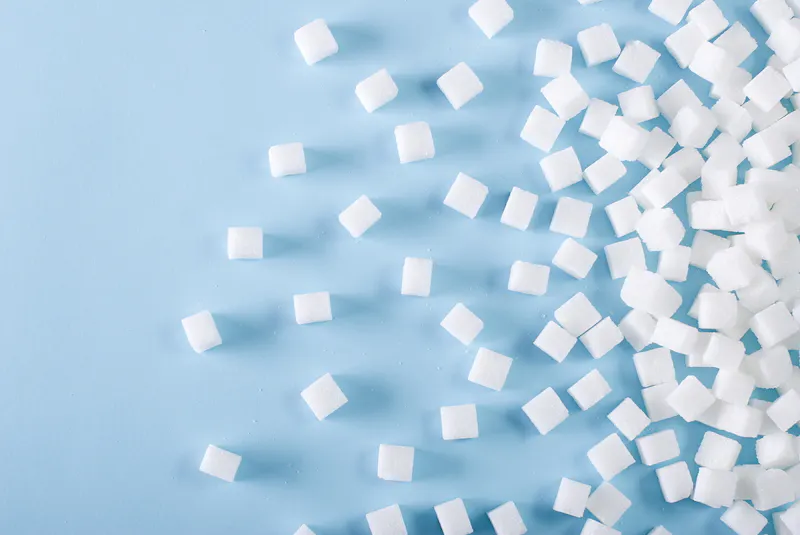Insulin resistance
What's covered?


Insulin is a hormone that helps control your blood sugar levels. If you’re insulin resistant, your cells don’t respond properly to insulin and it causes your blood sugar levels to stay high. This can lead to a number of diseases, particularly diabetes. Being overweight and carrying a lot of belly fat are the main risk factors for developing insulin resistance. An HbA1C blood test can check to see if you have this condition. If you do, there are a lot of lifestyle factors that can help reduce or reverse it.
What is insulin?
Insulin is a hormone produced by your pancreas. Its main function is to control the level of sugar (glucose) in your blood. Insulin also plays an important role in fat and protein metabolism.
When you eat, your blood sugar levels rise, and your pancreas releases insulin. Insulin then stimulates your cells to take up sugar from your blood — which they use for energy.
You can check your blood sugar control over the last 3 months by using an HbA1c blood test.
What is insulin resistance?
If your cells are less sensitive to the effects of insulin it’s called insulin resistance. This essentially means that your cells don’t respond to insulin properly and the sugar in your blood has trouble moving into your cells. This means your blood sugar levels stay high.
As a result, your pancreas produces more insulin which leads to high blood insulin levels (hyperinsulinemia). If this continues, your cells become even more resistant to the effects of insulin. And over time, your pancreas can become damaged because of the extra pressure put on it.
Overall, this causes your blood sugar levels to shoot up (hyperglycaemia) to an unhealthy level.
Risk factors for insulin resistance
The causes of insulin resistance are sometimes hard to pin down. But the main risk factor for insulin resistance is being overweight or obese. And you’re particularly at risk if you carry a lot of belly fat.
Other risk factors include:
- overeating
- lack of exercise
- inflammation
- eating or drinking lots of added sugars
- smoking
- ethnicity — some ethnicities, like Hispanics and Asians, are at an increased risk indicating that genetics might play a role
- gut microbiota imbalances — this can cause inflammation which increases the risk of insulin resistance
Signs of insulin resistance
Unfortunately, most people don’t show any signs of insulin resistance.
If you’re overweight and carry a lot of belly fat, you likely suffer from some degree of insulin resistance. High blood triglycerides (fats in your blood) and low HDL cholesterol are also commonly seen with insulin resistance.
Sometimes, you might get darkened skin on parts of your body — for example, your knees, knuckles, elbows, armpits, and neck. This is called acanthosis nigricans.
Side effects of insulin resistance
If left untreated, insulin resistance can lead to:
- prediabetes — when your blood sugar levels are higher than normal but not high enough to be classified as diabetes
- type 2 diabetes — in fact, over 50% of people with insulin resistance develop type 2 diabetes
- metabolic syndrome — a combination of conditions (high blood pressure, high blood sugar, excess belly fat, and abnormal cholesterol or triglycerides)
- heart disease
- fatty liver disease — a buildup of fat in your liver
- pancreatitis — when your pancreas becomes inflamed
- polycystic ovary syndrome (PCOS)
It might also increase your risk of Alzheimer’s disease and cancer.
How to test for insulin resistance
If you’re overweight and carry a lot of belly fat, it’s probably worth speaking with your doctor or doing a test to check for insulin resistance. A number of blood tests can be done which can indicate insulin resistance:
- fasting insulin — a high fasting insulin result would indicate that you’re insulin resistance
- An HbA1c blood test — measures your average blood sugar control over the last 3 months
- oral glucose tolerance test (OGTT) — checks your blood sugar levels before and after you take glucose drink
- homeostatic model assessment (HOMA) — measures your blood sugar and glucose levels
How to treat insulin resistance
The good news is that there are a lot of lifestyle changes you can make to improve or completely reverse your insulin resistance — ultimately lowering your blood sugar levels.
Exercise
Exercise is one of the most effective ways to reduce insulin resistance.
Eat a healthy diet
Eat a healthy diet full of whole grains, fruits, vegetables, oily fish, nuts and seeds. Avoid having too many processed and sugary foods. You could also try intermittent fasting — alternate between periods of fasting and periods of eating. There are a number of ways to do this, so it’s important to research this method of eating first and speak with a health professional.
Avoid smoking
If you smoke, quitting can really help to reduce your insulin resistance.
Get enough sleep
Aim for at least 7 hours every night.
Lower stress
If you are stressed a lot, you should try to lower your stress levels through things like yoga, meditation, and exercise.
Dandona, P., Aljada, A., & Bandyopadhyay, A. (2004). Inflammation: the link between insulin resistance, obesity and diabetes. Trends in immunology, 25(1), 4-7.
Grundy, S. M., Cleeman, J. I., Daniels, S. R., Donato, K. A., Eckel, R. H., Franklin, B. A., ... & Spertus, J. A. (2005). Diagnosis and management of the metabolic syndrome: an American Heart Association/National Heart, Lung, and Blood Institute scientific statement. Circulation, 112(17), 2735-2752.
Reaven, G. M. (1988). Role of insulin resistance in human disease. Diabetes, 37(12), 1595-1607.
Tabák, A. G., Herder, C., Rathmann, W., Brunner, E. J., & Kivimäki, M. (2012). Prediabetes: a high-risk state for diabetes development. The Lancet, 379(9833), 2279-2290.
Xu, H., Barnes, G. T., Yang, Q., Tan, G., Yang, D., Chou, C. J., ... & Chen, H. (2003). Chronic inflammation in fat plays a crucial role in the development of obesity-related insulin resistance. The Journal of clinical investigation, 112(12), 1821-1830.